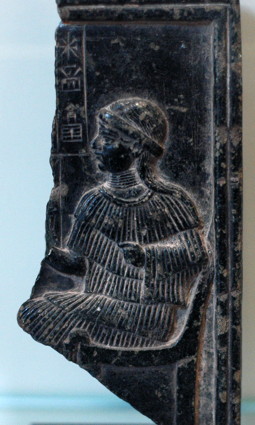Ninsumun (Ninsun) (goddess)
The divine mother of legendary king Gilgameš, she was married to Lugalbanda, a legendary king of Uruk and Gilgameš's father.
Functions

Possible image of the goddess Ninsumun on a fragmentary relief, dating to the late third millennium BCE. (Louvre, AO 2761)
Ninsumun is primarily known as the mother of legendary king Gilgameš. She appears in this function already in the Sumerian Gilgameš tales (ETCSL 1.8.1-5) dating to the Old Babylonian period (or possibly earlier) and continues to be mentioned in the Standard Babylonian Epic of Gilgameš (George 2003). In the Standard Babylonian version, in the first part of Tablet III, she pleads with the sun-god Šamaš on behalf of her son (George 2003: 575-583).
In an attempt to legitimize his deification, king Šulgi of the Third Dynasty of Ur (r. 2093-2046 BCE) placed himself within the divine genealogy of Gilgameš by claiming that Ninsumun and Lugalbanda were his divine parents and Gilgameš his brother (Michalowski 2012 [2008]).
An Early Dynastic literary text from Tell Abu Salabikh recounts the marriage between Lugalbanda and Ninsumun (Jacobsen 1989b) yet the text is difficult to understand and offers little information regarding the goddess's functions.
Divine Genealogy and Syncretisms
Some genealogical information was already mentioned in the Functions section. While Ninsumun appears not to have been syncretised with other goddesses, she was also close to the goddesses Baba and Gatumdu, and through this connection also became associated with the healing goddess Gula (Wilcke 1998-2001: 503).
Cult Place(s)
Ninsumun's main cult places were located within the city-state of Lagaš [~/images/Lagash.jpg], yet she was also worshipped in some of the major southern Mesopotamian cities, such as Nippur [~/images/Nippur.jpg], Ur [~/images/Ur.jpg], and Umma [~/images/Umma.jpg], as well as some minor localities (Wilcke 1998-2001: 503-4). According to Richter (2004: 323-25, with further literature), the goddess originated from Ku'ara, the home of the god Asalluhi.
The Ur III ruler Ur-Namma (r. 2011-2094 BCE) built a temple called Emah ("Magnificent Temple") in Ur [~/images/Ur.jpg] for her (George 1993: 119 no. 717), and the Standard Babylonian Epic of Gilgameš refers to her temple as the Egalmah (Tablet III, lines 15 et passim, George 2003: 575ff.), otherwise known as Gula's temple (George 1993: 88f. nos. 318-323).
During the Ur III period Ninsumun and Lugalbanda, as the divine parents of the Ur III kings, received offerings in Nippur [~/images/Nippur.jpg] on the occasion of several lunar festivals (Sallaberger 1993: 56). In Uruk [~/images/Uruk.jpg], the city from which the Ur III kings originated, and a nearby city named KI.KAL the divine couple continued to received offerings into the Old Babylonian period (Richter 2004: 321-23).
Time Periods Attested
Ninsumun is first attested in the Early Dynastic IIIa period (in god lists and literary texts), with attestations reaching into the Seleucid period.
Iconography
A stone relief at the Louvre Museum (see above) possibly shows the goddess (identified by her inscription) seated on a throne; her hair is long and she wears the flounced robe, an iconographic marker of divinity.
Name and Spellings
Ninsumun's name was originally read Ninsun. More recently the reading Ninsumun has been proven to be more accurate (Wilcke 1998-2001: 501-2). The name appears to be a genitive construction, meaning "Lady of the wild cows" (Wilcke ibid.).
- Written forms:
- dnin-sún, dnin-súmun, dnin-súmun-na (= dnin-súmun-ak), dnin-súmun-ka
- Normalised forms:
- Ninsun, Ninsuna (both obsolete), Ninsumun, Ninsumuna, Ninsumunak
Ninsumun (Ninsun) in Online Corpora
- The Cuneiform Digital Library Initiative
- The Electronic Text Corpus of Sumerian Literature
- The Electronic Text Corpus of Sumerian Royal Inscriptions
- The Corpus of Ancient Mesopotamian Scholarship
Further Reading
- Jacobsen 1989b, "Lugalbanda and Ninsuna."
- Wilcke 1998-2001, "Ninsun."
Nicole Brisch
Nicole Brisch, 'Ninsumun (Ninsun) (goddess)', Ancient Mesopotamian Gods and Goddesses, Oracc and the UK Higher Education Academy, 2019 [http://oracc.museum.upenn.edu/amgg/listofdeities/ninsumun/]